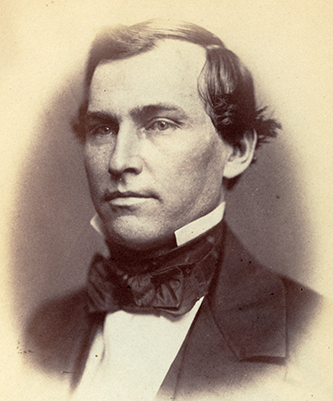28 Nov. 1820–17 Sept. 1862

Lawrence O'Bryan Branch, lawyer, U.S. congressman, and Confederate soldier, was born in Enfield of a prominent and wealthy family. His parents were Joseph and Susan Simpson O'Bryan Branch. The family lived in Tennessee until Joseph's death in 1827 (Susan had died two years earlier); Lawrence was returned to North Carolina to become a member of the household of his distinguished uncle, John Branch. When his kinsman was appointed secretary of the navy by President Andrew Jackson, young Branch went with him to Washington, D.C. After studying under several tutors, one of whom was Salmon P. Chase, he attended Bingham Military Academy in North Carolina. Then followed a short stay at The University of North Carolina and graduation with distinction from Princeton in 1838.
While working as a newspaper editor in Nashville, Tenn., Branch studied law. He was not admitted to the bar until he moved to Tallahassee, Fla., however, and then, because he was not of age, it took a special act of the territorial legislature to gain him his license in 1840. During the Seminole War he served as an aide to General Robert R. Reid. In 1844 he married Nancy Haywood Blount, daughter of General W. A. Blount of Washington, N.C. Four years later he moved to Raleigh to continue the practice of law.
In 1852, Branch became president of the Raleigh and Gaston Railroad Company. At the same time he started an active political career, having been chosen as an elector on the Democratic ticket of Franklin Pierce and William R. D. King. Despite a reluctance to run, he was elected to the U.S. House of Representatives in 1854 and was to serve in that body continuously from 1855 to 1861. He was not a candidate for renomination in 1860. As a staunch Southern Democrat, he spoke forcefully in defense of his district, state, and section; yet he never hesitated to caution the South against extremism. His speeches were primarily those of a southern moderate. Although he had been a constant supporter of the president in the House, in December 1860 he refused the position of secretary of the treasury in Buchanan's cabinet (once before he had declined a cabinet post, that of postmaster general).
Opposed to the "coercion" of the southern states, he advocated secession. When North Carolina withdrew from the Union, he enlisted as a private in the Raleigh Rifles, but shortly thereafter the governor appointed him state quartermaster general. Desiring service in the field, Branch resigned to become colonel of the Thirty-third North Carolina Regiment. On 17 Jan. 1862 he was promoted to brigadier general in the provisional Confederate Army. March 1862 found him in command of the Southern troops defending New Bern against Burnside's Union forces. Even though the loss of New Bern was a great blow to North Carolina, Branch escaped the scathing criticism leveled against a number of his fellow officers. To most observers he did about as well as could be expected from a "political general."
After retiring to Kinston, he was ordered to Virginia. His brigade, which consisted of the Seventh, Eighteenth, Twenty-eighth, Thirty-third, and Thirty-seventh North Carolina regiments was attached to A. P. Hill's division, Stonewall Jackson's corps. Action soon followed at Hanover Court House, the Seven Days' battles around Richmond, and the Second Manassas and Antietam campaigns. Branch was killed at Antietam. As a brigade commander in Hill's famous light division, he had led his troops on a rapid march from Harper's Ferry to Sharpsburg. He arrived on the field of battle in time to help stem the Union advance and save Lee's right flank from a crushing defeat. Soon afterward, as he stood talking with three fellow officers, he was hit by sharpshooter fire. He fell dying into the arms of a staff officer. General Hill wrote: "The Confederacy has to mourn the loss of a gallant soldier and accomplished gentleman. He was my senior brigadier, and one to whom I could have intrusted the command of the division, with all confidence." He left one son, W. A. B. Branch. Interment was in Old City Cemetery, Raleigh.